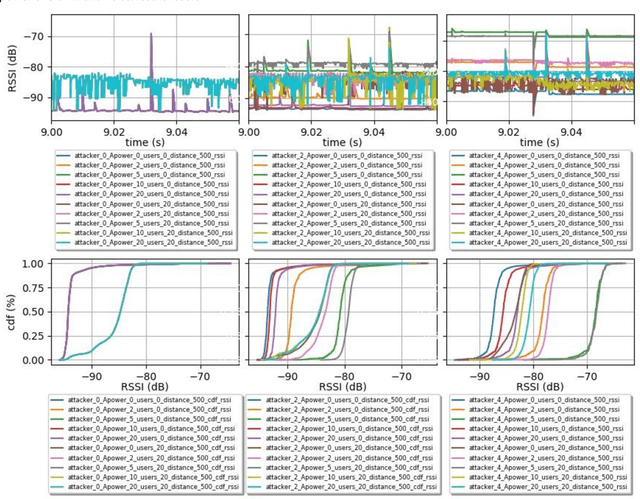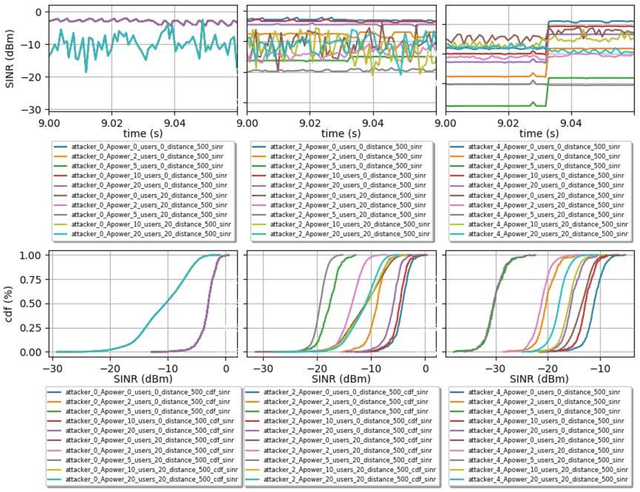Biljana Bojovic
A Synthetic Dataset for 5G UAV Attacks Based on Observable Network Parameters
Nov 05, 2022



Abstract:Synthetic datasets are beneficial for machine learning researchers due to the possibility of experimenting with new strategies and algorithms in the training and testing phases. These datasets can easily include more scenarios that might be costly to research with real data or can complement and, in some cases, replace real data measurements, depending on the quality of the synthetic data. They can also solve the unbalanced data problem, avoid overfitting, and can be used in training while testing can be done with real data. In this paper, we present, to the best of our knowledge, the first synthetic dataset for Unmanned Aerial Vehicle (UAV) attacks in 5G and beyond networks based on the following key observable network parameters that indicate power levels: the Received Signal Strength Indicator (RSSI) and the Signal to Interference-plus-Noise Ratio (SINR). The main objective of this data is to enable deep network development for UAV communication security. Especially, for algorithm development or the analysis of time-series data applied to UAV attack recognition. Our proposed dataset provides insights into network functionality when static or moving UAV attackers target authenticated UAVs in an urban environment. The dataset also considers the presence and absence of authenticated terrestrial users in the network, which may decrease the deep networks ability to identify attacks. Furthermore, the data provides deeper comprehension of the metrics available in the 5G physical and MAC layers for machine learning and statistics research. The dataset will available at link archive-beta.ics.uci.edu
Calibration of the 5G-LENA System Level Simulator in 3GPP reference scenarios
May 06, 2022



Abstract:Due to the rapid technology evolution and standardization activity in the mobile communication networks, there is the need for the research community to be able to develop, test and evaluate new and/or already xisting solutions before industrial or real-network implementation. As such, it is essential to have an open-source tool that provides an alternative solution to that of industrial proprietary simulators that are not available for public usage. ns-3 5G-LENA simulator is an end-to-end open-source NR system-level simulator that allows extensive research to be performed. However, it is of great importance to guarantee that the results obtained using the simulator can be comparable to that of industrial simulators and real networks. For this reason, calibrating the simulator based on 3GPP defined specifications is crucial. Based on the above, in this paper we calibrate the ns-3 5G-LENA simulator according to the 3GPP reference results for NR-based outdoor deployments. Moreover, we explore the REM feature provided by the simulator, to ease the calibration process and understand better the radio environment. Results show the resemblance of the simulator performance to that of simulators used as references by 3GPP.
ns-3 and 5G-LENA extensions to support MIMO
Feb 08, 2022



Abstract:MIMO spatial multiplexing is an essential feature to increase the communication data rates in current and future cellular systems. Currently, the ns-3 lte module leverages an abstraction model for 2x2 MIMO with spatial multiplexing of 2 streams; while mmwave and nr modules were lacking the spatial multiplexing option until this work, since the ns-3 models were not supporting the usage of multiple antennas for spatial multiplexing and an abstraction model such as the one used in the lte module is not suitable for the mmWave frequencies. In this paper, we propose, implement and evaluate 2-stream MIMO spatial multiplexing models for ns-3 and the nr module. The proposed extension for the ns-3 supports multiple antennas for MIMO spatial multiplexing and can be used by any ns-3 module that is compatible with the ns-3 antenna array based models, such as nr and mmwave modules. We leverage this ns-3 extension to model 2-stream MIMO by exploiting dual-polarized antennas and their orthogonality under line-of-sight conditions, as it happens at high frequency bands, to send the two data streams. The proposed model does not rely on abstraction, as the MIMO model in the ns-3 lte module, and can thus model more realistically the propagation differences of the two streams, correlation, inter-stream interference, and allows design and evaluation of the rank adaptation algorithms. Additionally, we propose and evaluate an adaptive rank adaptation scheme and compare it with a fixed scheme. The developed MIMO spatial multiplexing models for the ns-3 simulator and the nr module are openly available.
 Add to Chrome
Add to Chrome Add to Firefox
Add to Firefox Add to Edge
Add to Edge